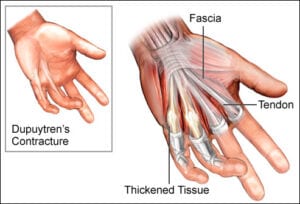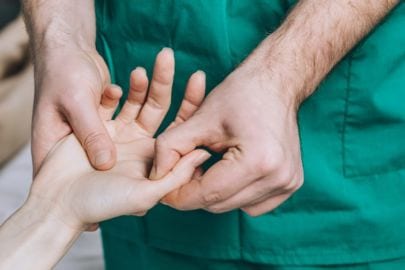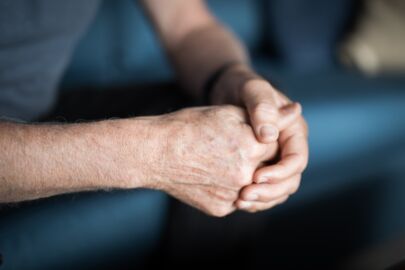What is Dupuytren’s Disease?
Dupuytren’s disease is one of the most common crippling conditions of the hand. Dupuytren’s disease is a benign, but chronic and progressive inherited disease that draws the fingers in over time, creating what is called a Dupuytren’s contracture.
Unfortunately, many people have never heard of the disease, may not recognize it when it affects them, and may not know that various treatments exist to correct deformities and improve hand function.
In Dupuytren’s disease, the fascia, a thick layer of tissue under the skin of the fingers and palm, becomes abnormal. Initially, small fibrous nodules develop in the fascia of the palm. Over the course of months to years, most nodules grow lengthwise into the fingers, forming thick cords. These cords then progressively tighten over time, drawing the fingers in. When the fingers cannot straighten, a “contracture” has been created.
When the fingers are contracted, function of the hand suffers. The hand may not open fully to grasp objects. It may be difficult to lay the hand flat on a table, fit the hand into a glove, or place the hand into a pocket.
Tens of millions of Americans suffer from Dupuytren’s disease. Although Caucasians are most commonly affected, anyone can develop the condition. Men are more severely affected than women, and symptoms typically begin after age 50. There is no known prevention or cure for Dupuytren’s disease.

How Do You Get Dupuytren’s Disease?
Dupuytren’s disease is an inherited condition. The inheritance often skips generations, and the severity of the disease will vary from person to person. While in some, the condition is mild and contractures may never develop, in others with severe disease the progression can be rapid, multiple fingers and both hands can be affected, and other body parts such as the feet or the penis may be affected.
Dupuytren’s disease is often overlooked. As a painless condition that occurs in older people and in early stages, may not have any contracture, Dupuytren’s disease may not be noticed initially. Use of the hand for gripping is usually unimpeded until later stages where the fingers are more severely contracted. In addition, it may be confused for various other conditions of the hand, such as cysts, tumors, or arthritis.
There are various treatments, including surgery, that can help restore hand function. These work by removing, or at least cutting, the diseased tissue, allowing the fingers to straighten once again.
Do you believe you are suffering from Dupuytren’s Disease? We are here to help. Request your appointment today.




